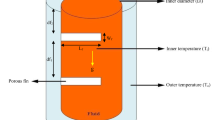Abstract
Among tubular heat exchangers, fin-tube types are the most widely used in refrigeration and air-conditioning equipment. Efforts to enhance the performance of these heat exchangers included variations in the fin shape from a plain fin to a slit and louver type. In the context of heat transfer augmentation, the performance of vortex generators has also been investigated. Delta winglet vortex generators have recently attracted research interest, partly due to experimental data showing that their addition to fin-tube heat exchangers considerably reduces pressure loss at heat transfer capacity of nearly the same level. The efficiency of the delta winglet vortex generators widely varies depending on their size and shape, as well as the locations where they are implemented. In this paper, the flow field around delta winglet vortex generators in a common flow up arrangement was analyzed in terms of flow characteristics and heat transfer using computational fluid dynamics methods. Flow mixing due to vortices and delayed separation due to acceleration influence the overall fin performance. The fin with delta winglet vortex generators exhibited a pressure loss lower than that of a plain fin, and the heat transfer performance was enhanced at high air velocity or Reynolds number.
Similar content being viewed by others
References
K. Chang and P. Long, An experimental study of the airside performance of slit fin-and-tube heat exchangers under dry and wet conditions, International Journal of Air-Conditioning and Refrigeration, 17(1) (2009) 7–14.
G. B. Schubauer and W. G. Spangenberg, Forced mixing in boundary layers, Journal of Fluid Mechanics, 8 (1960) 10–31.
M. Fiebig, Vortices, generators and heat transfer, Trans Institution of Chemical Engineers, 76: Part A (1998).
K. Torii, K. M. Kwak and K. Nishino, Heat transfer enhancement accompanying pressure-loss reduction with winglet-type vortex generators for fin-tube heat exchanger, International Journal of Heat and Mass Transfer, 45 (2002) 3795–3801.
A. M. Jacobi and R. K. Shah, Heat transfer surface enhancement through the use of longitudinal vortices: A review of recent progress, Experimental Thermal and Fluid Science, 11 (1995) 295–309.
M. Fiebig, A. Valencia and N. K. Mitra, Wing-type vortex generators for fin-and-tube heat exchangers, Experimental Thermal and Fluid Science, 7 (1993) 287–295.
K. M. Kwak, K. Torii and K. Nishino, Heat transfer and pressure loss penalty for the number of tube rows of staggered finned-tube bundles with a single transverse row of winglets, International Journal of Heat and Mass Transfer, 46 (2003) 175–180.
K. M. Kwak, K. Torii and K. Nishino, Simultaneous heat transfer enhancement and pressure loss reduction for finnedtube bundles with the first or two transverse rows of built-in winglets, Experimental Thermal and Fluid Science, 29 (2005) 625–632.
A. Joardar and A. M. Jacobi, Heat transfer enhancement by winglet-type vortex generator arrays in compact plain-finandtube heat exchanger, International Journal of refrigeration, 31 (2008) 87–97.
C. B. Allison and B. B. Dally, Effect of a delta-winglet vortex pair on the performance of a tube-fin heat exchanger, International Journal of Heat and Mass Transfer, 50 (2007) 5065–5072.
J. Min and W. Xu, Numerical prediction of the performances of the fins with punched delta winglets and the louver fins and their comparison, Journal of Enhanced Heat Transfer, 12(4) (2005) 357–371.
B. R. Munson, D. F. Young and T. H. Okiishi, Fundamentals of fluid mechanics, 4th edition. Wiley (2002).
CD-adapco, Methodology manual, STAR-CD (2006).
F. P. Incropera, D. P. Dewitt, T. L. Bergman and A. S. Lavine, Introduction to heat transfer, 5th edition. Wiley (2007).
S. Kakac, H. Liu, Heat exchangers, CRC Press (1998).
K. J. Kim and P. A. Durbin, Observations of the frequencies in a sphere wake and drag increase by acoustic excitation. Physics of Fluids, 31 (1998) 3260–3265.
C. C. Wang, K. Y. Chi and C. J. Chang, Heat transfer and friction characteristics of plain fin-and-tube heat exchangers, part II: Correlation. International Journal of Heat and Mass Transfer, 43 (2000) 2693–2700.
R. K. Shah and K. London, Laminar flow forced convection in ducts, Academic Press, 1978.
Author information
Authors and Affiliations
Corresponding author
Additional information
Recommended by Associate Editor Man-Yeong Ha
Seong Won Hwang received his Master’s degree for Mechanical Engineering at the Pusan National University in 2010. He is currently a Ph.D. candidate. His research interests include heat exchanger performance tests and CFD analyses. He is currently working on heat exchangers with offset strip fins and vortex generators.
Dong Hwan Kim received his Master’s degree for Mechanical Engineering at the Pusan National University in 2011. He works on heat transfer enhancement and its application to energy systems.
June Kee Min studied in KAIST and received his Ph.D. in 1999. He worked for LG Electronics and Samsung Electronics as a thermo-fluid engineer for over 10 years. He joined the Rolls-Royce Pusan National University Technology Center in 2008. His research interests mainly include CFD-based fluid flow and heat transfer problems, such as heat exchangers, HVAC&R, and the thermal management of power storage systems.
Ji Hwan Jeong received his Ph.D. from the KAIST in 1995. His post-doctoral research was conducted at the Technology Centre in Aerodynamics and Heat Transfer at Oxford University. After three years of research at the Korea Atomic Energy Research Institute, he joined the faculty of the School of Mechanical Engineering at Pusan National University. His research interests include multi-phase flow, nuclear safety, heat exchangers, heat pump, and computational fluid dynamics. He has also consulted for the nuclear and air conditioner industries.
Rights and permissions
About this article
Cite this article
Hwang, S.W., Kim, D.H., Min, J.K. et al. CFD analysis of fin tube heat exchanger with a pair of delta winglet vortex generators. J Mech Sci Technol 26, 2949–2958 (2012). https://doi.org/10.1007/s12206-012-0702-2
Received:
Revised:
Accepted:
Published:
Issue Date:
DOI: https://doi.org/10.1007/s12206-012-0702-2




